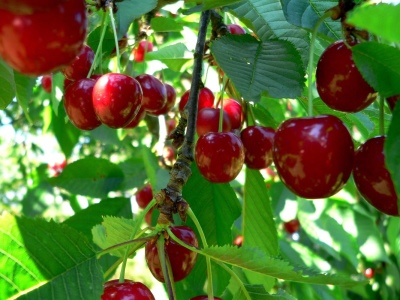
- Year of approval: 1959
- Barrel type: wood
- Growth type: vigorous
- Crown: wide pyramidal, weeping with age, medium density
- Flowering and fruiting type: mainly on annual increments
- Fruit size: small
- Fruit shape: flat-round
- Fruit color: dark red
- Fruit weight, g: 2,5
- Pulp color : Dark red
This variety has been approved for use since 1959. It has an average yield and high resistance to temperature extremes. The variety is considered unpretentious to care for.
Description of the variety
Cherry Shubinka belongs to the vigorous type. An adult plant can reach a height of 4 meters. The tree has a wide-pyramidal crown, with age it becomes weeping. Its density is average.
Cherry blossoms mainly on annual growths. The branches on the tree are quite thick and dark brown in color. The leaf plates are dark green in color, their size is medium.
The leaves are oval with a pointed end. There are small denticles on the edges. The tree blooms with small flowers that combine into inflorescences. The buds are white. Loosely pressed petals form a corolla.
Fruit characteristics
The fruits are small in size. The weight of one berry can be on average as low as 2.5 grams. The shape of the cherry is flat-round, the color is dark red. A pronounced abdominal suture can be observed on the berries. The size of the bone is average. The separation of the fruits is wet.
The skin on ripe fruits is shiny and thin. Their pulp is dark red, it has an average density.
Taste qualities
The taste of Shubinka cherries is mediocre, sour. As a rule, such cherries are not eaten raw. It can be excellent for processing into a variety of sweet dishes.
Ripening and fruiting
The Shubinka variety belongs to the late species. The fruits ripen in late July - early August, so the variety is best used for cultivation in the southern regions, where the warm season lasts for a longer time.
Cherry Shubinka is a self-fertile variety. To get a crop, you need to pollinate the flowers with pollen of a different variety (cross-pollination).

Yield
The species has an average yield. 6-12 tons of ripe berries can be harvested from one hectare of land planted.
Landing
These vigorous trees should be planted in a 2.5x3 meter pattern.


Growing and care
Like many other varieties, the crop will not need feeding for the first year after planting. But at the same time, weeding and watering must be carried out regularly.
Only a year later, the vegetation is fed with fertilizers, which contain nitrogen and potassium. In the autumn period, it is recommended to add potassium-phosphorus components.
This cherry, like most other varieties, is prone to overgrowth formation, so it must be destroyed immediately. Otherwise, the yield of trees will significantly decrease.
The species is vigorous, it grows rapidly to a large size, so periodic pruning will be necessary. The first such procedure is performed before landing.
Shubinka is a frost-resistant variety. But it is still recommended to prepare it for the onset of winter. For this, it is better to wrap the boles tightly with straw. Then all this is covered with a special film material.


Disease and pest resistance
Cherry Shubinka has medium resistance to various diseases. Most often it is affected by coccomycosis. This fungal disease affects the leaf plates. In advanced cases, it also damages the fruit. When infested, a large number of small red dots can be seen on vegetation. There is also a pink bloom on the lower part of the foliage.
In order to prevent contamination of the culture, it is necessary to clean the ground of fallen leaves annually, to carefully loosen the soil around the plantings. In the spring season, it is better to treat the plants with a solution of urea or Bordeaux liquid.
Shubinka can also be affected by shoot moths. This pest first eats the buds, buds and ovaries, and then goes on to young leaves. The development of harmful caterpillars occurs underground, so you can get rid of the parasite through periodic digging and loosening. You can also use insecticides.
































































